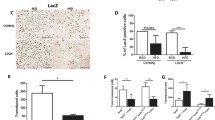Abstract
Biologic therapies involve the utilization of proteins, DNA, antibodies, or other substances derived or synthesized from living tissue for therapeutic effects. There are several biologic therapies in clinical development for the prevention and treatment of atherosclerosis. The most advanced in human trials are apolipoprotein mimetics, which include apolipoprotein A-1 Milano and phospholipid complexes. Infusions of these apolipoprotein mimetics have been demonstrated to reduce atherosclerotic development in both animal models and humans. Autoimmunization to create neutralizing antibodies to cholesteryl ester transfer protein is also in human trials. Gene therapies to reduce low-density lipoproteins and increase high-density lipoproteins are on the horizon, but the ability to safely prolong gene expression in humans will require the development of novel vectors.
Similar content being viewed by others
References and Recommended Reading
Cavazzana-Calvo M, Hacein-Bey S, de Saint Basile G, et al.: Gene therapy of human severe combined immunodeficiency (SCID)-X1 disease. Science 2000, 288:669–672.
Lehrman S: Virus treatment questioned after gene therapy death. Nature 1999, 401:517–518.
Ferber D: Gene therapy. Safer and virus-free? Science 2001, 294:1638–1642.
Freedman SB: Clinical trials of gene therapy for atherosclerotic cardiovascular disease. Curr Opin Lipidol 2002, 13:653–661.
Bekeredjian R, Chen S, Frenkel PA, et al.: Ultrasound-targeted microbubble destruction can repeatedly direct highly specific plasmid expression to the heart. Circulation 2003, 108:1022–1026.
Raper SE, Grossman M, Rader DJ, et al.: Safety and feasibility of liver-directed ex vivo gene therapy for homozygous familial hypercholesterolemia. Ann Surg 1996, 223:116–126.
Grossman M, Rader DJ, Muller DW, et al.: A pilot study of ex vivo gene therapy for homozygous familial hypercholesterolaemia. Nat Med 1995, 1:1148–1154.
Grossman M, Raper SE, Kozarsky K, et al.: Successful ex vivo gene therapy directed to liver in a patient with familial hypercholesterolaemia. Nat Genet 1994, 6:335–341.
Plump AS, Scott CJ, Breslow JL: Human apolipoprotein A-I gene expression increases high density lipoprotein and suppresses atherosclerosis in the apolipoprotein E-deficient mouse. Proc Natl Acad Sci USA 1994, 91:9607–9611.
Navab M, Anantharamaiah GM, Hama S, et al.: Oral administration of an apo A-I mimetic peptide synthesized from D-amino acids dramatically reduces atherosclerosis in mice independent of plasma cholesterol. Circulation 2002, 105:290–292.
Shah PK, Yano J, Reyes O, et al.: High-dose recombinant apolipoprotein A-Imilano mobilizes tissue cholesterol and rapidly reduces plaque lipid and macrophage content in apolipoprotein E-deficient mice: potential implications for acute plaque stabilization. Circulation 2001, 103:3047–3050.
Chiesa G, Sirtori CR: Apolipoprotein A-IMilano: current perspectives. Curr Opin Lipidol 2003, 14:159–163.
Chiesa G, Sirtori CR: Recombinant apolipoprotein A-I(Milano): a novel agent for the induction of regression of atherosclerotic plaques. Ann Med 2003, 35:267–273.
Chiesa G, Monteggia E, Marchesi M, et al.: Recombinant apolipoprotein A-I(Milano) infusion into rabbit carotid artery rapidly removes lipid from fatty streaks. Circ Res 2002, 90:974–980.
Eriksson M, Carlson LA, Miettinen TA, Angelin B: Stimulation of fecal steroid excretion after infusion of recombinant proapolipoprotein A-I. Potential reverse cholesterol transport in humans. Circulation 1999, 100:594–598.
Angelin B, Parini P, Eriksson M: Reverse cholesterol transport in man: promotion of fecal steroid excretion by infusion of reconstituted HDL. Atheroscler Suppl 2002, 3:23–30.
Newton RS, Krause BR: HDL therapy for the acute treatment of atherosclerosis. Atheroscler Suppl 2002, 3:31–38.
Esperion Therapeutics, Inc.: Regression of atherosclerosis seen with ETC-216 (AIM). News release: June 26, 2003.
Esperion Therapeutics: Internal data on file.
Shimano H, Yamada N, Katsuki M, et al.: Plasma lipoprotein metabolism in transgenic mice overexpressing apolipoprotein E. Accelerated clearance of lipoproteins containing apolipoprotein B. J Clin Invest 1992, 90:2084–2091.
Fan J, Ji ZS, Huang Y, et al.: Increased expression of apolipoprotein E in transgenic rabbits results in reduced levels of very low density lipoproteins and an accumulation of low density lipoproteins in plasma. J Clin Invest 1998, 101:2151–2164.
Yamada N, Shimano H, Mokuno H, et al.: Increased clearance of plasma cholesterol after injection of apolipoprotein E into Watanabe heritable hyperlipidemic rabbits. Proc Natl Acad Sci U S A 1989, 86:665–669.
Datta G, Garber DW, Chung BH, et al.: Cationic domain 141-150 of apoE covalently linked to a class A amphipathic helix enhances atherogenic lipoprotein metabolism in vitro and in vivo. J Lipid Res 2001, 42:959–966.
Tall AR: An overview of reverse cholesterol transport. Eur Heart J 1998, 19(suppl A):A31-A35.
Whitlock ME, Swenson TL, Ramakrishman R, et al.: Monoclonal antibody inhibition of cholesteryl ester transfer protein activity in the rabbit. Effects on lipoprotein composition and high density lipoprotein cholesteryl ester metabolism. J Clin Invest 1989, 84:129–137.
Brown ML, Inazu A, Hesler CB, et al.: Molecular basis of lipid transfer protein deficiency in a family with increased high-density lipoproteins. Nature 1989, 342:448–451.
Moriyama Y, Okamura T, Inazu A, et al.: A low prevalence of coronary heart disease among subjects with increased high density lipoprotein cholesterol levels, including those with plasma cholesteryl ester transfer protein deficiency. Prev Med 1998, 27:659–687.
Hirano K, Yamashita S, Nakajima N, et al.: Genetic cholesteryl ester transfer protein deficiency is extremely frequent in the Omagari area of Japan marked hyperalphalipoproteinemia caused by CETP gene mutation is not associated with longevity. Arterioscler Thromb Vasc Biol 1997, 17:1053–1059.
Stein O, Stein Y: Atheroprotective mechanisms of HDL. Atherosclerosis 1999, 144:285–301.
Rittershaus CW, Miller DP, Thomas LJ, et al.: Vaccine-induced antibodies inhibit CETP activity in vivo and reduce aortic lesions in a rabbit model of atherosclerosis. Arterioscler Thromb Vasc Biol 2000, 20:2106–2112.
Davidson MH, Maki K, Umporowicz D, et al.: The safety and immunogenicity of a CETP vaccine in healthy adults. Atherosclerosis 2003, 169:113–120.
Author information
Authors and Affiliations
Rights and permissions
About this article
Cite this article
Davidson, M.H. Biologic therapies for dyslipidemia. Curr Atheroscler Rep 6, 69–72 (2004). https://doi.org/10.1007/s11883-004-0118-2
Issue Date:
DOI: https://doi.org/10.1007/s11883-004-0118-2




